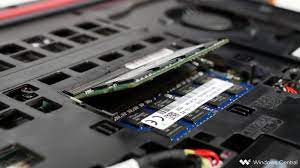Don’t even think about doing anything to your work laptop before checking your company’s IT and device policies. Depending on their concerns, and what contracts they’ve signed with clients, you might be limited in what you’re allowed to do. Also ask if they have a “bring your own device” policy, and see if another laptop you own fits the bill.
If they give you the green light, the next step is to get a full list of the machine’s specs, including any information on the make and model, which you can find by looking at the bottom of your laptop. This will give you a shortcut when determining whether a part or external gadget will work with your machine. Take note of what ports you have, and whether or not they’re powered—the more ports, the more you can add.
While you’re checking the bottom of your laptop look for removable panels and access points. Ultralight, newer laptops tend to have more parts glued into place, or to be made entirely out of one piece of metal. In some cases, cracking open the case is impossible, so you’ll be stuck with external accessories for those.
This is also a good time to back up your files. Put anything you need easy access to into cloud storage, and everything else onto a USB stick or an external hard drive.
Once that’s done, clean out any files you don’t need and perform some basic maintenance, like defragmenting your hard drive. This will improve performance by getting all your information in one place, and give you more room.
There are some quick ways to improve your laptop’s performance, in some cases with stuff you already have at your desk.
Start with your RAM. This is your computer’s “short-term memory,” where they store all the data they need to keep things running—and there’s only so much of it to go around. When the built-in RAM runs out, your computer will start using your hard drive’s memory to keep the system going. This isn’t ideal: Hard drives have strict speed limits thanks to their moving parts, so programs will slow down waiting for data to come. USB sticks, though, are limited only by the speed of your USB port, so you can turn them into “virtual RAM” with a few clicks.
In Windows, connect the USB drive and, in File Explorer, right-click on its icon. Choose Properties and under the ReadyBoost tab, select Dedicate this device to ReadyBoost. Click on Apply and OK, and finish by rebooting your machine.
There is one caveat—your USB stick will burn out faster than it normally would, due to the high workload. It’s a good idea to dedicate a few sticks specifically for this job, and remove any files you have stored on them first. You don’t want any of these flash drives to die on you while storing important files.
If your hard drive is taking forever to open large files, consider an external solid-state drive, or SSD, which you can also connect via USB-C. SSDs have no moving parts, so they’re much faster than traditional magnetic disc drives. They usually set themselves up automatically and are portable as well, so it can come with you.
If work for you involves a lot of graphically intense tasks like CAD design or data visualization, an external graphics processing unit, or GPU, can help out. External GPUs are more popular among gamers, but they can work for any application, and if you have a spare graphics card, you can buy an enclosure for it and plug it into a port without having to open up your laptop.
Source : https://www.popsci.com/diy/upgrade-work-laptop/









